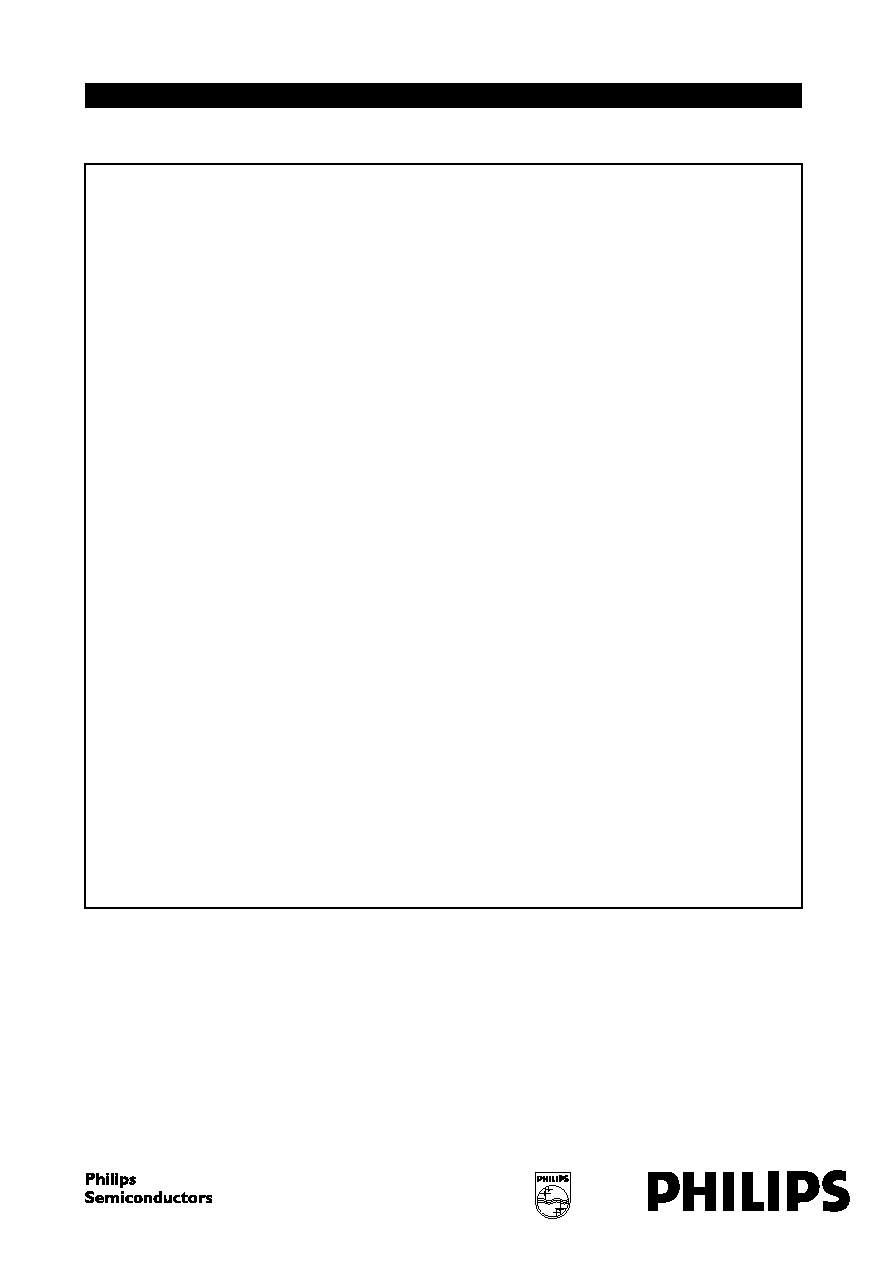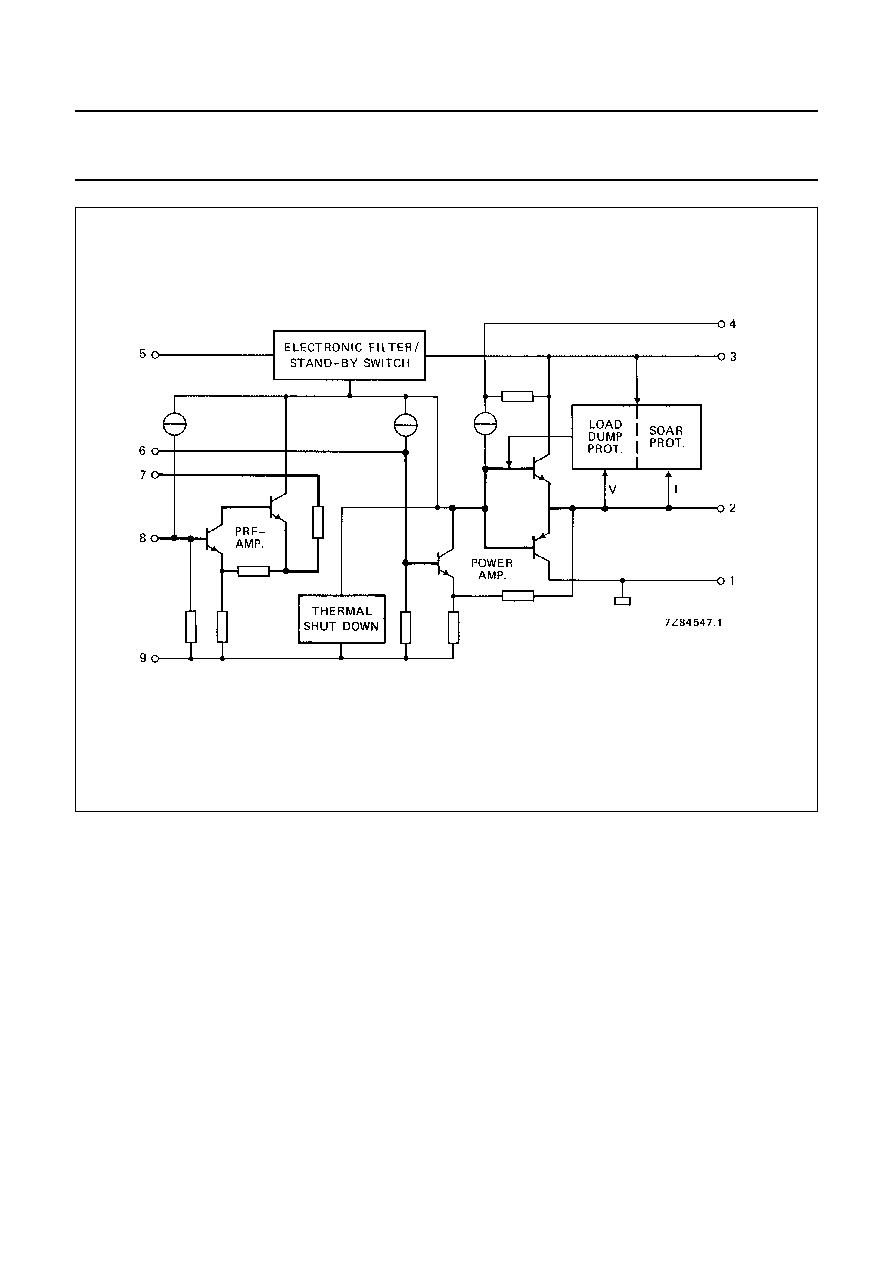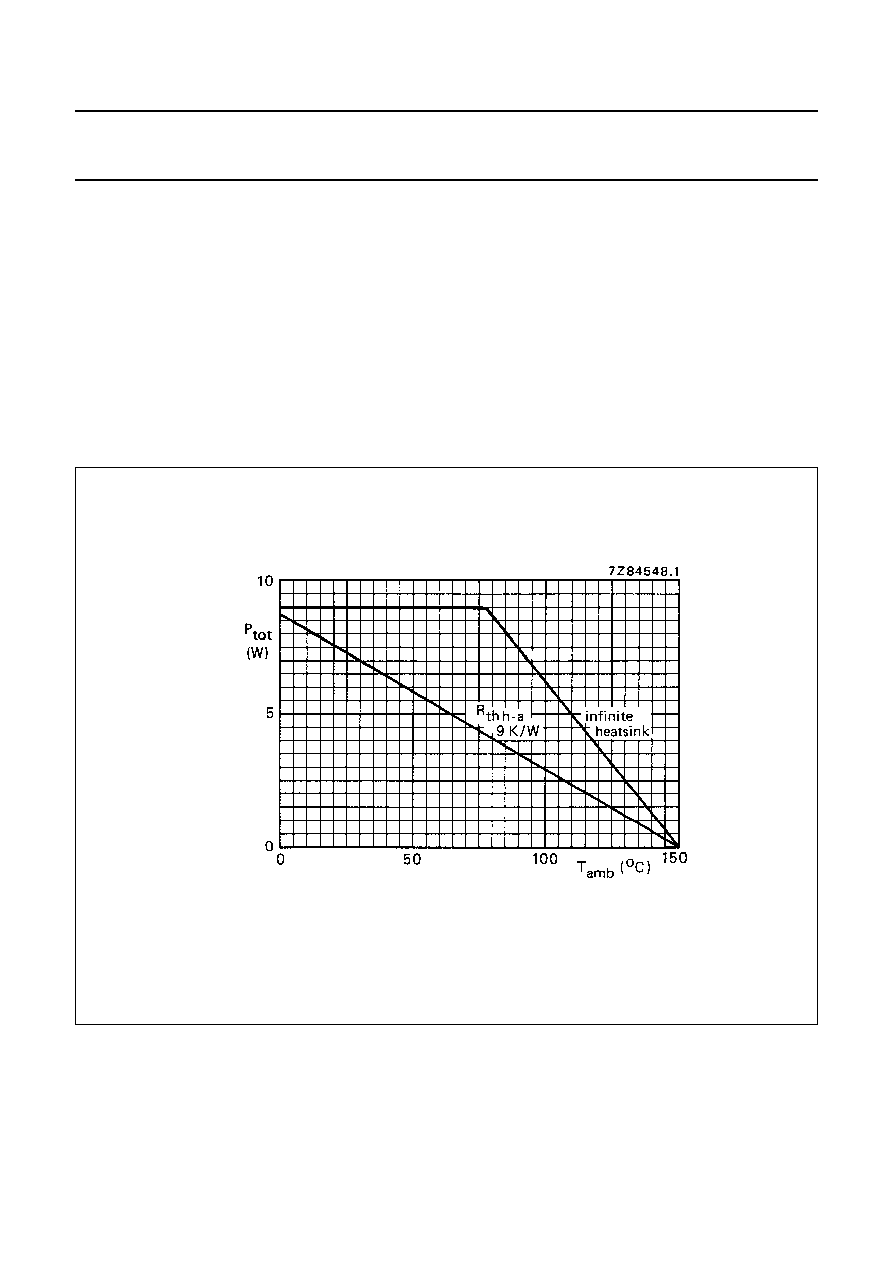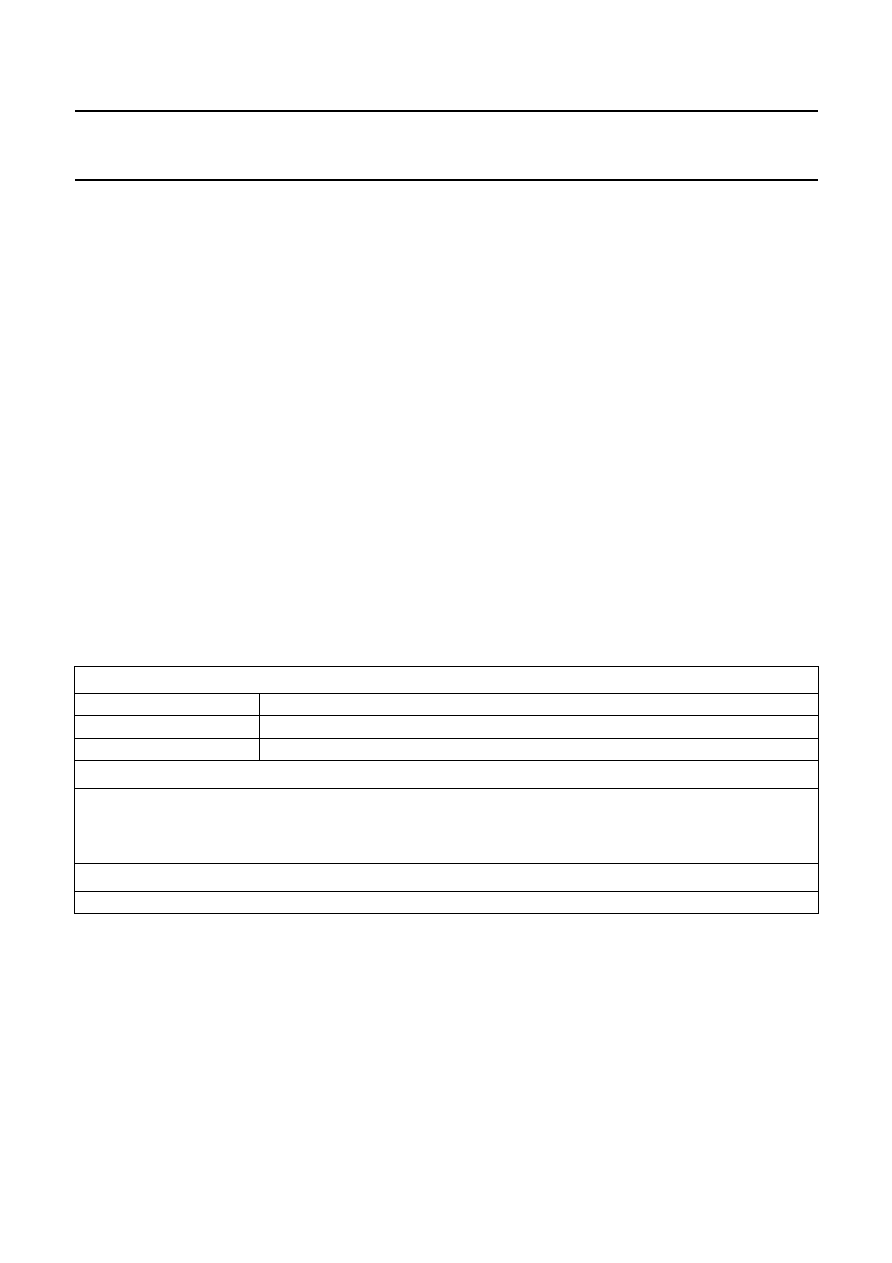Document Outline
- QUICK REFERENCE DATA
- PACKAGE OUTLINE
- PINNING
- RATINGS
- HEATSINK DESIGN EXAMPLE
- D.C. CHARACTERISTICS
- A.C. CHARACTERISTICS
- PACKAGE OUTLINE
- SOLDERING
- DEFINITIONS
- LIFE SUPPORT APPLICATIONS

DATA SHEET
Product specification
File under Integrated Circuits, IC01
November 1982
INTEGRATED CIRCUITS
TDA1020
12 W car radio power amplifier

November 1982
2
Preliminary Specification
Philips Semiconductors
Product specification
12 W car radio power amplifier
TDA1020
The TDA1020 is a monolithic integrated 12 W audio amplifier in a 9-lead single in-line (SIL) plastic package. The device
is primarily developed as a car radio amplifier. At a supply voltage of V
P
=
14,4 V, an output power of 7 W can be delivered
into a 4
load and 12 W into 2
.
To avoid interferences and car ignition signals coming from the supply lines into the IC, frequency limiting is used beyond
the audio spectrum in the preamplifier and the power amplifier.
The maximum supply voltage of 18 V makes the IC also suitable for mains-fed radio receivers, tape recorders or record
players. However, if the supply voltage is increased above 18 V (< 45 V), the device will not be damaged (load dump
protected). Also a short-circuiting of the output to ground (a.c.) will not destroy the device. Thermal protection is built-in.
As a special feature, the circuit has a low stand-by current possibility.
The TDA1020 is pin-to-pin compatible with the TDA1010.
QUICK REFERENCE DATA
PACKAGE OUTLINE
9-lead SIL; plastic (SOT110B); SOT110-1; 1996 July 24.
Supply voltage range
V
P
6 to 18 V
Repetitive peak output current
I
ORM
<
4 A
Output power at d
tot
= 10% (with bootstrap)
V
P
= 14,4 V; R
L
= 2
P
o
>
10 W
typ.
12 W
V
P
= 14,4 V; R
L
= 4
P
o
typ.
7 W
V
P
= 14,4 V; R
L
= 8
P
o
typ.
3,5 W
Output power at d
tot
= 10% (without bootstrap)
V
P
= 14,4 V; R
L
= 4
P
o
>
4,5 W
Input impedance
preamplifier (pin 8)
|Z
i
|
typ.
40 k
power amplifier (pin 6)
|Z
i
|
typ.
40 k
Total quiescent current at V
P
= 14,4 V
I
tot
typ.
30 mA
Stand-by current
I
sb
<
1 mA
Storage temperature range
T
stg
-
55 to + 150
∞
C
Crystal temperature
T
c
max.
150
∞
C

November 1982
3
Preliminary Specification
Philips Semiconductors
Product specification
12 W car radio power amplifier
TDA1020
PINNING
1. Negative supply (substrate)
2. Output power stage
3. Positive supply (V
P
)
4. Bootstrap
5. Ripple rejection filter
6. Input power stage
7. Output preamplifier
8. Input preamplifier
9. Negative supply
Fig.1 Internal block diagram; the heavy lines indicate the signal paths.

November 1982
4
Preliminary Specification
Philips Semiconductors
Product specification
12 W car radio power amplifier
TDA1020
RATINGS
Limiting values in accordance with the Absolute Maximum System (IEC 134)
Supply voltage; operating (pin 3)
V
P
max.
18 V
Supply voltage; non-operating
V
P
max.
28 V
Supply voltage; load dump
V
P
max.
45 V
Non-repetitive peak output current
I
OSM
max.
6 A
Total power dissipation
see derating curves Fig.2
Storage temperature range
T
stg
-
55 to + 150
∞
C
Crystal temperature
T
c
max.
150
∞
C
Short-circuit duration of load behind output electrolytic capacitor
at 1 kHz sine-wave overdrive (10 dB); V = 14,4 V
t
sc
max.
100 hours
Fig.2 Power derating curves.

November 1982
5
Preliminary Specification
Philips Semiconductors
Product specification
12 W car radio power amplifier
TDA1020
HEATSINK DESIGN EXAMPLE
The derating of 8 K/W of the encapsulation requires the following external heatsink (for sine-wave drive):
10 W in 2
at V
P
=
14,4 V
maximum sine-wave dissipation: 5,2 W
T
amb
=
60
∞
C maximum
Since R
th j-tab
+
R
th tab-h
=
8 K/W, R
th h-a
=
17,3
-
8
9 K/W.
D.C. CHARACTERISTICS
A.C. CHARACTERISTICS
T
amb
= 25
∞
C; V
P
= 14,4 V; R
L
= 4
; f = 1 kHz; unless otherwise specified; see also Fig.3
Supply voltage range (pin 3)
V
P
6 to 18 V
Repetitive peak output current
I
ORM
<
4 A
Total quiescent current
at V
P
= 14,4 V
I
tot
typ.
30 mA
at V
P
= 18 V
I
tot
typ.
40 mA
Output power at d
tot
= 10%; with bootstrap (note 1)
V
P
= 14,4 V; R
L
= 2
P
o
>
10 W
typ.
12 W
V
P
= 14,4 V; R
L
= 4
P
o
>
6 W
typ.
7 W
V
P
= 14,4 V; R
L
= 8
P
o
typ.
3,5 W
Output power at d
tot
= 1%; with bootstrap (note 1)
V
P
= 14,4 V; R
L
= 2
P
o
typ.
9,5 W
V
P
= 14,4 V; R
L
= 4
P
o
typ.
6 W
V
P
= 14,4 V; R
L
= 8
P
o
typ.
3 W
Output voltage (r.m.s. value)
R
L
= 1 k
; d
tot
= 0,5%
V
o(rms)
typ.
5 V
Output power at d
tot
= 10%; without bootstrap
P
o
>
4,5 W
Voltage gain
preamplifier (note 2)
G
v1
typ.
17,7 dB
16,7 to 18,7 dB
power amplifier
G
v2
typ.
29,5 dB
28,5 to 30,5 dB
total amplifier
G
v tot
typ.
47 dB
46,2 to 48,2 dB
R
th j-a
R
th j-tab
R
th tab-h
R
th h-a
150
60
≠
5 2
,
----------------------
17,3 K/W
=
=
+
+
=

November 1982
6
Preliminary Specification
Philips Semiconductors
Product specification
12 W car radio power amplifier
TDA1020
Notes
1. Measured with an ideal coupling capacitor to the speaker load.
2. Measured with a load resistor of 40 k
.
3. Measured according to IEC curve-A.
4. Maximum ripple amplitude is 2 V; input is short-circuited.
5. Total current when disconnecting pin 5 or short-circuited to ground (pin 9).
6. The tab must be electrically floating or connected to the substrate (pin 9).
Input impedance
preamplifier
|Z
i
|
typ.
40 k
28 to 52 k
power amplifier
|Z
i
|
typ.
40 k
28 to 52 k
Output impedance
preamplifier
|Z
o
|
typ.
2,0 k
1,4 to 2,6 k
power amplifier
|Z
o
|
typ.
50 m
Output voltage (r.m.s. value) at d
tot
= 1%
preamplifier (note 2)
V
o(rms)
>
1 V
typ.
1,5 V
Frequency response
B
50 Hz to 25 kHz
Noise output voltage (r.m.s. value; note 3)
R
S
= 0
V
n(rms)
typ.
0,3 mV
<
0,5 mV
R
S
= 8,2 k
V
n(rms)
typ.
0,5 mV
<
1,0 mV
Ripple rejection (note 4)
at f = 100 Hz; C2 = 1
µ
F
RR
typ.
44 dB
at f = 1 kHz to 10 kHz
RR
>
48 dB
typ.
54 dB
Bootstrap current at onset of clipping (pin 4)
R
L
= 4
and 2
I
4
typ.
40 mA
Stand-by current (note 5)
I
sb
<
1 mA
Crystal temperature for
-
3 dB gain
T
c
>
150
∞
C

November 1982
7
Preliminary Specification
Philips Semiconductors
Product specification
12 W car radio power amplifier
TDA1020
Fig.3 Test circuit.
(1) With R
L
= 2
, preferred value of C8 = 2200
µ
F.

November 1982
8
Preliminary Specification
Philips Semiconductors
Product specification
12 W car radio power amplifier
TDA1020
PACKAGE OUTLINE
UNIT
A
A
max.
2
A
3
b
1
D
1
b
2
b
c
D
(1)
E
(1)
Z
max.
(1)
e
L
P
P
1
q
1
q
2
q
REFERENCES
OUTLINE
VERSION
EUROPEAN
PROJECTION
ISSUE DATE
IEC
JEDEC
EIAJ
mm
18.5
17.8
3.7
8.7
8.0
A
4
15.8
15.4
1.40
1.14
0.67
0.50
1.40
1.14
0.48
0.38
21.8
21.4
21.4
20.7
6.48
6.20
3.4
3.2
2.54
1.0
5.9
5.7
4.4
4.2
3.9
3.4
15.1
14.9
Q
1.75
1.55
DIMENSIONS (mm are the original dimensions)
Note
1. Plastic or metal protrusions of 0.25 mm maximum per side are not included.
2.75
2.50
SOT110-1
92-11-17
95-02-25
0
5
10 mm
scale
0.25
w
D
E
A
A
c
A
2
3
A
4
q
1
q
2
L
Q
w
M
b
b
1
b
2
D
1
P
q
1
Z
e
1
9
P
seating plane
pin 1 index
SIL9MPF: plastic single in-line medium power package with fin; 9 leads
SOT110-1

November 1982
9
Preliminary Specification
Philips Semiconductors
Product specification
12 W car radio power amplifier
TDA1020
SOLDERING
Introduction
There is no soldering method that is ideal for all IC packages. Wave soldering is often preferred when through-hole and
surface mounted components are mixed on one printed-circuit board. However, wave soldering is not always suitable for
surface mounted ICs, or for printed-circuits with high population densities. In these situations reflow soldering is often
used.
This text gives a very brief insight to a complex technology. A more in-depth account of soldering ICs can be found in our
"IC Package Databook" (order code 9398 652 90011).
Soldering by dipping or by wave
The maximum permissible temperature of the solder is 260
∞
C; solder at this temperature must not be in contact with the
joint for more than 5 seconds. The total contact time of successive solder waves must not exceed 5 seconds.
The device may be mounted up to the seating plane, but the temperature of the plastic body must not exceed the
specified maximum storage temperature (T
stg max
). If the printed-circuit board has been pre-heated, forced cooling may
be necessary immediately after soldering to keep the temperature within the permissible limit.
Repairing soldered joints
Apply a low voltage soldering iron (less than 24 V) to the lead(s) of the package, below the seating plane or not more
than 2 mm above it. If the temperature of the soldering iron bit is less than 300
∞
C it may remain in contact for up to
10 seconds. If the bit temperature is between 300 and 400
∞
C, contact may be up to 5 seconds.
DEFINITIONS
LIFE SUPPORT APPLICATIONS
These products are not designed for use in life support appliances, devices, or systems where malfunction of these
products can reasonably be expected to result in personal injury. Philips customers using or selling these products for
use in such applications do so at their own risk and agree to fully indemnify Philips for any damages resulting from such
improper use or sale.
Data sheet status
Objective specification
This data sheet contains target or goal specifications for product development.
Preliminary specification
This data sheet contains preliminary data; supplementary data may be published later.
Product specification
This data sheet contains final product specifications.
Limiting values
Limiting values given are in accordance with the Absolute Maximum Rating System (IEC 134). Stress above one or
more of the limiting values may cause permanent damage to the device. These are stress ratings only and operation
of the device at these or at any other conditions above those given in the Characteristics sections of the specification
is not implied. Exposure to limiting values for extended periods may affect device reliability.
Application information
Where application information is given, it is advisory and does not form part of the specification.








